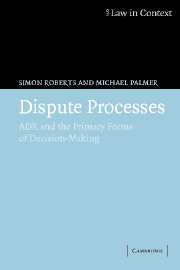Book contents
- Frontmatter
- Contents
- Preface
- Acknowledgements
- 1 Introduction
- 2 Cultures of Decision-making: Precursors to the Emergence of ADR
- 3 The Debates Around Civil Justice and the Movement Towards Procedural Innovation
- 4 Disputes and Dispute Processes
- 5 Negotiations
- 6 Mediation
- 7 Umpiring
- 8 Hybrid Forms and Processual Experimentation
- 9 The Trajectory of Alternative Dispute Resolution
- Bibliography
- Index
4 - Disputes and Dispute Processes
Published online by Cambridge University Press: 05 June 2012
- Frontmatter
- Contents
- Preface
- Acknowledgements
- 1 Introduction
- 2 Cultures of Decision-making: Precursors to the Emergence of ADR
- 3 The Debates Around Civil Justice and the Movement Towards Procedural Innovation
- 4 Disputes and Dispute Processes
- 5 Negotiations
- 6 Mediation
- 7 Umpiring
- 8 Hybrid Forms and Processual Experimentation
- 9 The Trajectory of Alternative Dispute Resolution
- Bibliography
- Index
Summary
Introduction
Lawyers represent disputes as ‘cases’ – discrete, bounded and pathological episodes, generated by rule-breach. They are, in everyday language, ‘messes’ which need to be ‘cleared up’. In the lawyer's view they are most appropriately cleared up in a particular way, through ‘litigation’. This is a process under which, ideally, evenly matched adversaries fight it out – through their legal representatives – on the level playing field of the ‘justice system’. In native legal theory, litigation culminates in a final moment of adjudication in which a neutral third party reaches an authoritative determination; although, as we have already seen, lawyers have in practice come to use litigation as the vehicle for their negotiating strategies, and in so doing ‘settle’ the great majority of causes before judgment.
Within this universe of meaning, disputes are affairs of ‘naming, blaming and claiming’ as Felstiner, Abel and Sarat put it (Extract 4:1). An individual perceives herself or himself as suffering some injurious experience, identifies this as originating in a legal wrong, blames someone for this and institutes a claim against that someone, setting in train a process that will put the matter to rights. Lawyers representing the parties then reshape the dispute into a form suitable for processing in the legal system, typically transforming it in doing so.
- Type
- Chapter
- Information
- Dispute ProcessesADR and the Primary Forms of Decision-Making, pp. 79 - 112Publisher: Cambridge University PressPrint publication year: 2005

